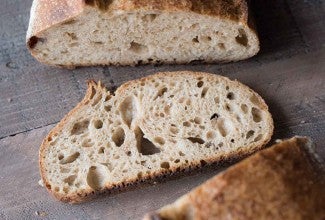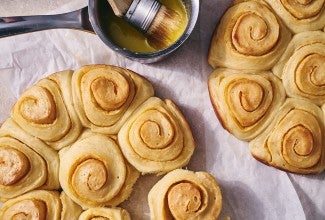-
Weigh your flour; or measure it by gently spooning it into a cup, then sweeping off any excess.
-
To make the sponge: In a medium-sized mixing bowl, or in the bucket of your bread machine, mix the starter and the flour together. Mix in the water. Stir for several minutes to activate the gluten. (If you're using a bread machine for this step, cancel after about 6 minutes of kneading.)
-
Cover and set aside in a warm (70°F to 90°F) place for 18 to 20 hours. When ready, the sponge should have expanded by about one-third (or more), and developed bubbles and a pleasing aroma. You may do this step up to 7 days ahead, then refrigerate until ready to use the sponge. (If you want to enhance the sour flavor, substitute 1/2 cup rye or whole wheat flour for 1/2 cup of the unbleached all-purpose flour in your sponge.)
-
To make the dough: Add the flour to the sponge along with the water, salt and yeast. Note that this amount of water called for in the dough is a guideline. You may need to add a tablespoon or two more in the winter, or use a little less in the summer.
Stir to form a shaggy mass, then let the mixture sit for 20 to 30 minutes. (This resting period, called the autolyse, allows the flour to absorb the water before you start kneading; it will make kneading easier, and also help prevent you from adding too much flour to the dough.)
-
To knead the dough: Turn the dough out onto a lightly greased work surface. (Using a lightly floured work surface is OK, but the idea is not to work too much flour into the dough. A dough that's slack and slightly sticky will produce a loaf with much better texture. Many people knead in too much flour, thinking the dough is too sticky to work with, then end up with dry or crumbly bread.) The dough starts out sticky, so a bench scraper is a handy tool. When the dough is kneaded enough, about 8 to 10 minutes by hand, 6 to 8 minutes in an electric mixer or bread machine, or about 90 seconds in a food processor, it will feel firm, slightly sticky, and elastic. If it feels too dry, sprinkle a little water over it and incorporate until it feels tacky and soft enough to "relax."
-
Place the dough in a greased bowl, turning to cover all sides, cover the bowl, and set it in a warm place (though not above 90°F). Don't try to rush the dough by raising it at a temperature above 90°; the best bread rises slowly, so give the dough time. After an hour, and again at the 2-hour mark, gently deflate it and fold it over a few times to redistribute the yeast and oxygen, and dispel some of the carbon dioxide. In 2 to 3 hours the dough should have almost doubled.
-
To shape the dough: Turn the dough out onto a lightly greased work surface. Divide the dough in half, and form each half into a round. Let the dough rest for 20 minutes or so, covered; then form the pieces into whatever shapes you prefer — round, oval or baguette. Raising your loaves in a couche or a banneton will help them achieve a thick, chewy crust. If you don't have any of these, use a linen (or other smooth — not terry cloth) dishtowel to line a round bowl. Heavily flour the forms you're using, place the shaped loaves in them seam-side up, and cover.
-
Let the loaves rise for 2 or more hours; the dough should have almost doubled. Note: If you want really big holes in your loaves and loads of flavor, dust them with flour, cover, and refrigerate overnight (without letting them rise first).
-
Preheat your oven to 475°F for 30 minutes. If your loaves have been refrigerated, remove them from the fridge, and let them rest, still covered, at room temperature, while you preheat your oven, about 30 minutes. Once the loaves have come to room temperature, turn them out onto a floured baker's peel (if you have a baking stone in your oven), or onto lightly floured baking sheets. For risen, unrefrigerated loaves, turn them out the same way (onto a peel or pan).
-
Slash the loaves several times using a lame, sharp knife or razor blade. Just before placing the loaves in the oven, spritz them several times with water.
-
To bake the bread: Put the loaves into the oven, spritz with water after 30 seconds, and again at 1 minute and 2 minutes. Turn the oven temperature down to 450°F and bake for 18 to 25 minutes. Be sure the bread is baked through, and the crust well browned. The bread should feel firm and sound hollow when tapped, and its internal temperature should read 195°F on an instant-read thermometer. Much of the flavor is concentrated in a deep brown crust, so don't be afraid to bake it until it's good and dark.
-
Remove the bread from the oven. Now tilt your head close, and listen: as the bread cools, you should hear it crackle. This is the sound of a good loaf. It's hard not to tear off a piece right away, but the bread is still baking and developing flavor as it cools — it really will taste better after an hour of cooling.
-
Storage information: Store the bread on the counter for a day or two, or freeze for up to 3 months. Once you've opened and used some of the starter packet, close it tightly and freeze the rest for up to 6 months.




















